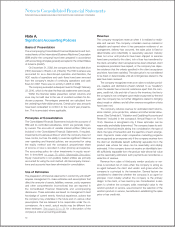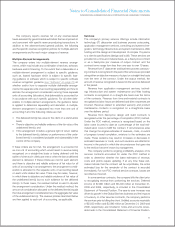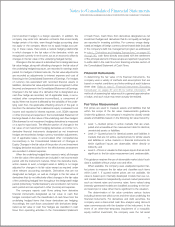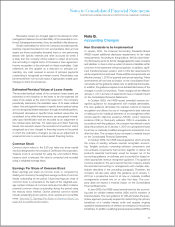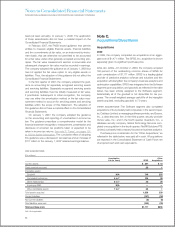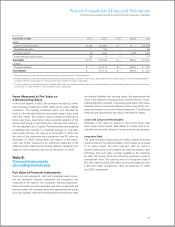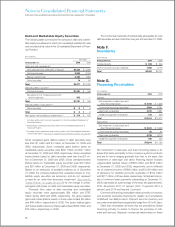IBM 2009 Annual Report Download - page 81
Download and view the complete annual report
Please find page 81 of the 2009 IBM annual report below. You can navigate through the pages in the report by either clicking on the pages listed below, or by using the keyword search tool below to find specific information within the annual report.
Notes to Consolidated Financial Statements
INTERNATIONAL BUSINESS MACHINES CORPORATION AND SUBSIDIARY COMPANIES
Receivable losses are charged against the allowance when
management believes the uncollectibility of the receivable is con-
firmed. Subsequent recoveries, if any, are credited to the allowance.
Certain receivables for which the company recorded specific
reserves may also be placed on non-accrual status. Non-accrual
assets are those receivables (impaired loans or non-performing
leases) with specific reserves and other accounts for which it
is likely that the company will be unable to collect all amounts
due according to original terms of the lease or loan agreement.
Income recognition is discontinued on these receivables. Cash
collections are first applied as a reduction to principal out-
standing. Any cash received in excess of principal payments
outstanding is recognized as interest income. Receivables may
be removed from non-accrual status, if appropriate, based upon
changes in client circumstances.
Estimated Residual Values of Lease Assets
The recorded residual values of the company’s lease assets are
estimated at the inception of the lease to be the expected fair
value of the assets at the end of the lease term. The company
periodically reassesses the realizable value of its lease residual
values. Any anticipated increases in specific future residual values
are not recognized before realization through remarketing efforts.
Anticipated decreases in specific future residual values that are
considered to be other-than-temporary are recognized immedi-
ately upon identification and are recorded as an adjustment to
the residual-value estimate. For sales-type and direct financing
leases, this reduction lowers the recorded net investment and is
recognized as a loss charged to financing income in the period
in which the estimate is changed, as well as an adjustment to
unearned income to reduce future-period financing income.
Common Stock
Common stock refers to the $.20 par value per share capital
stock as designated in the company’s Certificate of Incorporation.
Treasury stock is accounted for using the cost method. When
treasury stock is reissued, the value is computed and recorded
using a weighted-average basis.
Earnings Per Share of Common Stock
Basic earnings per share of common stock is computed by
dividing net income by the weighted-average number of common
shares outstanding for the period. Diluted earnings per share of
common stock is computed on the basis of the weighted-aver-
age number of shares of common stock plus the effect of dilutive
potential common shares outstanding during the period using
the treasury stock method. Dilutive potential common shares
include outstanding stock options, stock awards and convertible
notes. See note R, “Earnings Per Share of Common Stock,” on
page 104 for additional information.
Note B.
Accounting Changes
New Standards to be Implemented
In January 2010, the Financial Accounting Standards Board
(FASB) issued additional disclosure requirements for fair value
measurements. According to the guidance, the fair value hierar-
chy disclosures are to be further disaggregated by class of assets
and liabilities. A class is often a subset of assets or liabilities within
a line item in the statement of financial position. In addition, signif-
icant transfers between Levels 1 and 2 of the fair value hierarchy
will be required to be disclosed. These additional requirements are
effective January 1, 2010 for quarterly and annual reporting. These
amendments will not have an impact on the consolidated finan-
cial results as this guidance relates only to additional disclosures.
In addition, the guidance requires more detailed disclosures of the
changes in Level 3 instruments. These changes will be effective
January 1, 2011 and are not expected to have a material impact
on the Consolidated Financial Statements.
In October 2009, the FASB issued amended revenue rec-
ognition guidance for arrangements with multiple deliverables.
The new guidance eliminates the residual method of revenue
recognition and allows the use of management’s best estimate
of selling price for individual elements of an arrangement when
vendor-specific objective evidence (VSOE), vendor objective
evidence (VOE) or third-party evidence (TPE) is unavailable. In
accordance with the guidance, the company has elected to early
adopt its provisions as of January 1, 2010 on a prospective basis
for all new or materially modified arrangements entered into on or
after that date. The company does not expect a material impact
on the Consolidated Financial Statements.
In October 2009, the FASB issued guidance which amends
the scope of existing software revenue recognition account-
ing. Tangible products containing software components and
non-software components that function together to deliver the
product’s essential functionality would be scoped out of the
accounting guidance on software and accounted for based on
other appropriate revenue recognition guidance. This guidance
must be adopted in the same period that the company adopts
the amended accounting for arrangements with multiple deliv-
erables described in the preceding paragraph. Therefore, the
company will also early adopt this guidance as of January 1,
2010 on a prospective basis for all new or materially modified
arrangements entered into on or after that date. The com-
pany does not expect a material impact on the Consolidated
Financial Statements.
In June 2009, the FASB issued amendments to the account-
ing rules for variable interest entities (VIEs) and for transfers of
financial assets. The new guidance for VIEs eliminates the quan-
titative approach previously required for determining the primary
beneficiary of a variable interest entity and requires ongoing
qualitative reassessments of whether an enterprise is the primary
beneficiary. In addition, qualifying special purpose entities (QSPEs)
79



